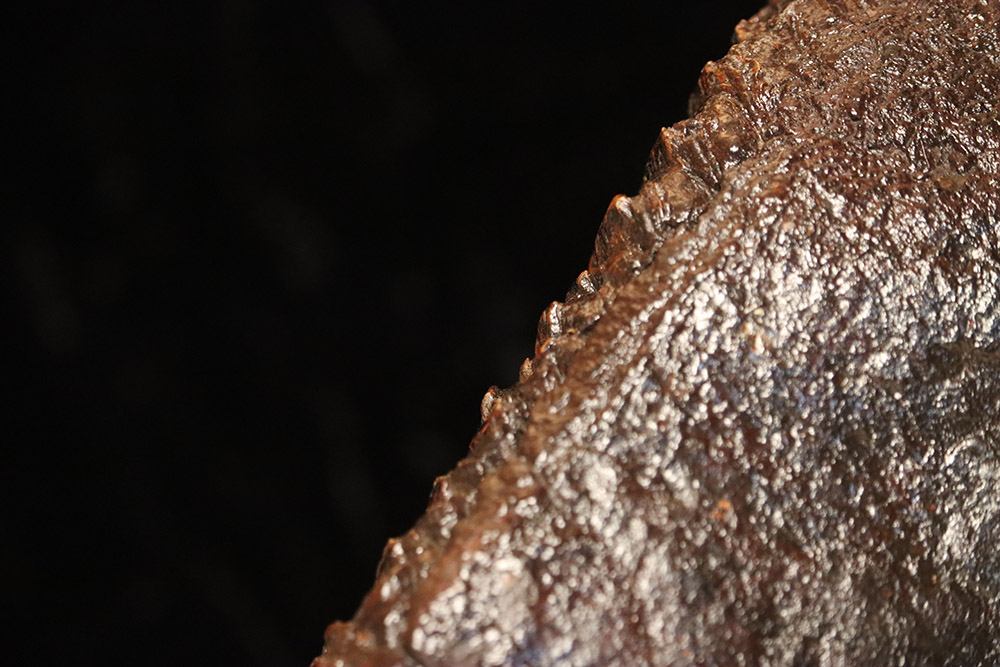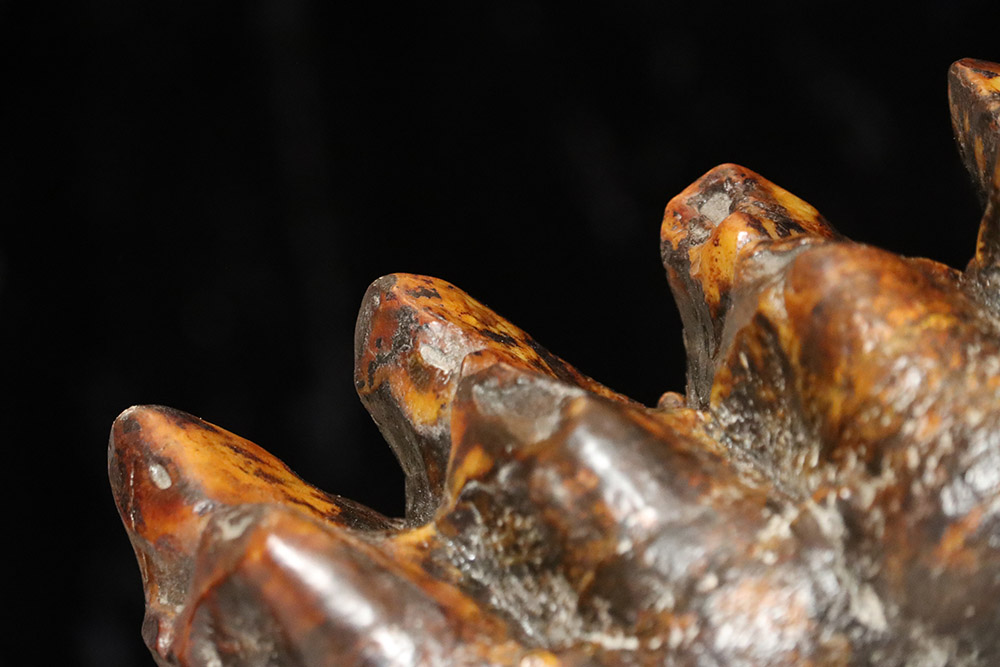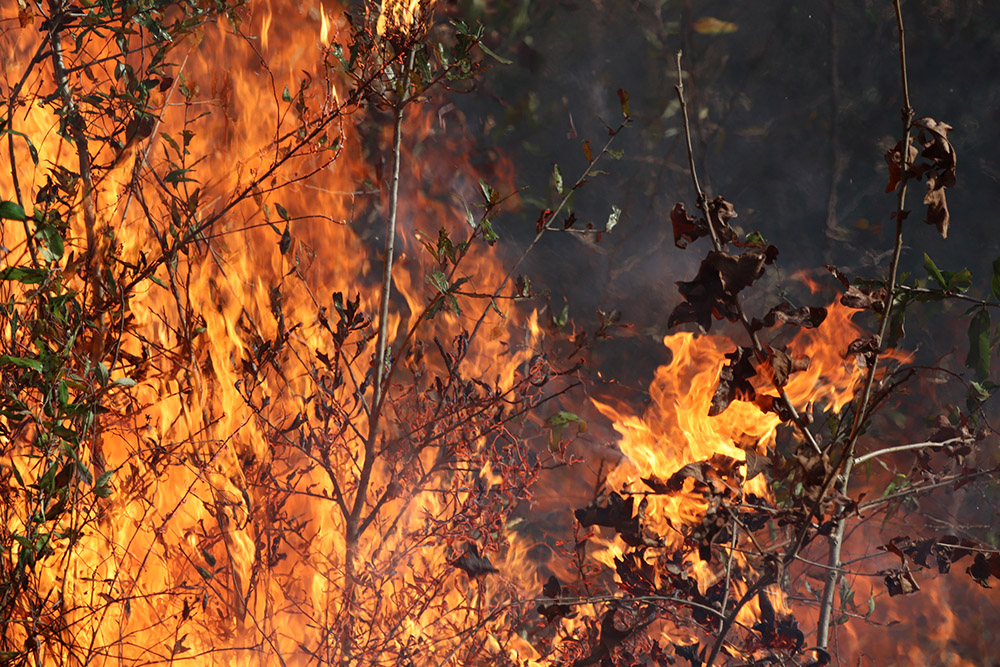I’m interviewing Dr. Richard Hulbert before a long row of bone-filled shelves. Until his retirement a couple of years ago, Richard oversaw the Division of Vertebrate Paleontology at the Florida Museum of Natural History. We’re in the Museum’s warehouse, in Gainesville, and the bones behind him represent millions of years of Florida fauna.
As with many of my interviews for this documentary, our talk turns to the Aucilla River.
“The shelves behind me are essentially the results of, I would say, close to 40 years of intense excavations on multiple sites in the Aucilla River, and the nearby Wacissa,” Richard says. The Columbian mammoth you see when you first walk into the Museum’s exhibit hall is also from the Aucilla. The Aucilla/ Wacissa River basin might be Florida’s fossil hotspot.
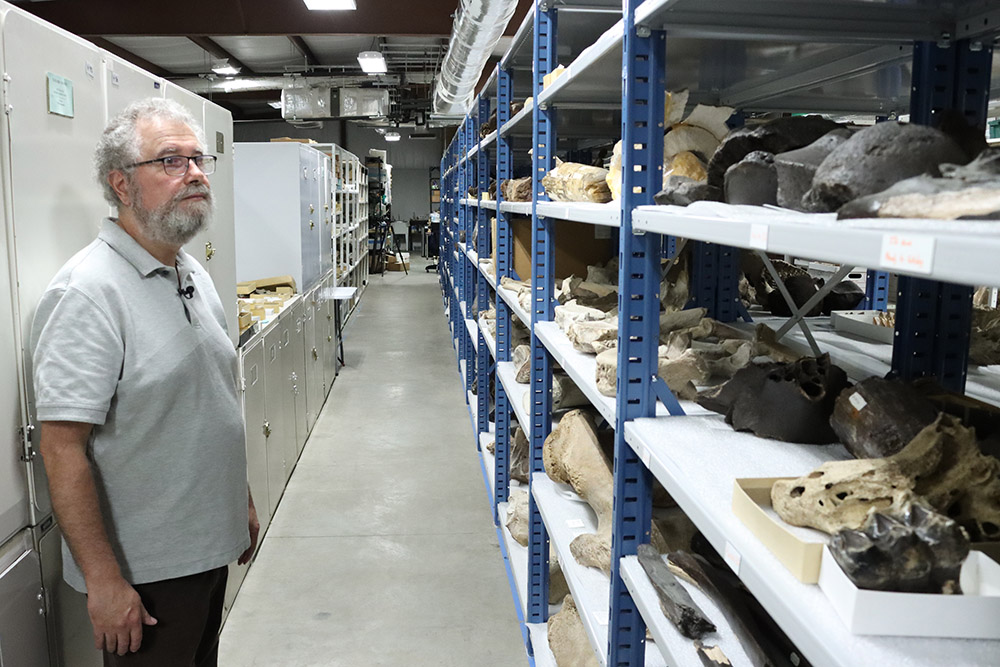
After the interview, we walk up the aisle. We see mastodon teeth, ground sloth claws, the horns of a bison. The darker fossils have been browned from exposure to oxygen, while those that kept their bone color had been better preserved in sediments.
As we near the end of the row, I’m surprised to meet a celebrity.
“This is the famous, supposed ‘worked’ tusk from the Aucilla,” he says. It’s a tusk excavated by archeologists from the Page-Ladson site. The site is a big reason so many archeologists I’ve interviewed talk about the Aucilla; it’s one of the oldest in North America. Somewhere on this tusk should be marks believed to have been made by humans…
Finding the First Floridians
WFSU’s newest documentary digs into the sediments beneath Florida’s abundant waterways. Here, archeologists are finding prehistoric sites, some of which are older than many had previously thought would be possible in Florida. Florida is an epicenter of submerged prehistory, and the last decade or so has seen a renewed effort to excavate sites.
- Chapter 1: Florida’s Ice Age Landscape
- Chapter 2: Rising Seas and Flowing Rivers
- Chapter 3: Prehistoric Cultures Adapt to Change

Pioneering submerged prehistory
…but we can’t find them. That’s because researchers sliced the tusk to extract information from it. The Museum has a single section of it here, and it isn’t the section that kept archeologists returning to a sinkhole in the Aucilla River.
Dr. James Dunbar and Dr. David Webb were the first to excavate the site, in the 1980s and 90s. They found the tusk in a layer with preserved mastodon digestive remains – poop, to state it plainly. In that layer, they also found bones of an extinct llama and horse, a bison, and a few stone artifacts made by humans. They dated the layer to about 14,500 years ago, over a thousand years older than the oldest accepted dates for humans in the Americas.
It was an eye-opening date, but the finds weren’t widely accepted. Dr. Michael Waters is the Director of the Center for the Study of the First Americans at Texas A&M University. He remembers how Dunbar and Webb’s findings were – or weren’t – received. “They presented this evidence, but people said, well, those artifacts, maybe they fell in[to that sediment layer] or they weren’t paying attention. And so it just became forgotten.”
The date was too early, and the site was under water.
In the 1980s and 90s, archeologists like Dunbar and Dr. Michael Faught adapted terrestrial techniques to a submerged setting. In time, this would revolutionize archeology in the watery state of Florida, but first, they had to sell terrestrial archeologists on their methods. Could archeology be done scientifically under water?
In 2012, Michael Waters’ then-graduate student, Dr. Jessi Halligan, restarted excavations at Page-Ladson after years of inactivity. Her team found a stone knife in the poop layer and confirmed the initial dates. This time, the world took notice. Humans and mastodons coexisted in Florida, an idea that had once seemed inconceivable. For over a thousand years, humans also shared a landscape with giant sloths, saber-toothed cats, tapirs – almost thirty species no longer found in Florida.
Those animals can, directly and indirectly, provide a window into the world of the First Floridians.
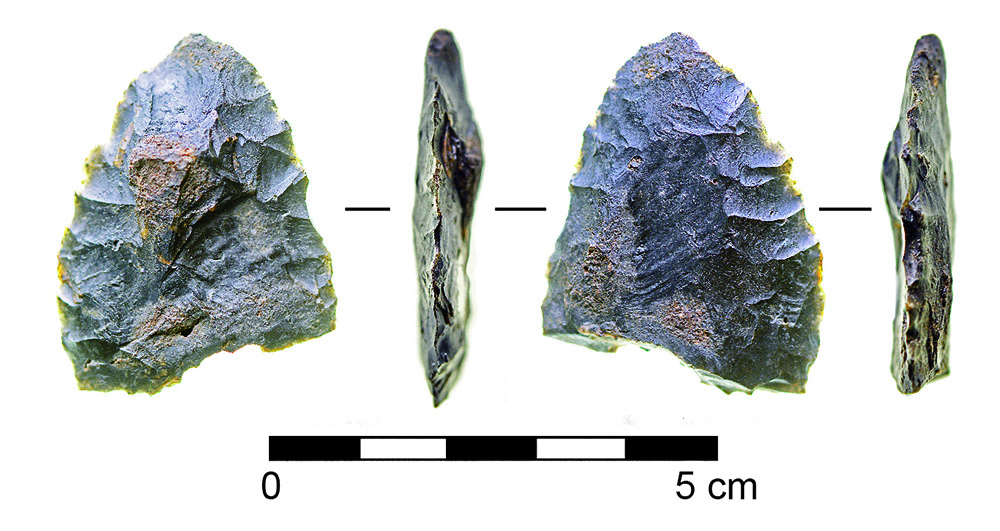
How do we start to envision the Florida of the First Floridians?
We now know humans have been here for at least 14,500 years, possibly longer. At the time, the earth had been changing for thousands of years and would continue to do so for thousands more. It was the end of the Pleistocene, the last ice age. A few thousand years earlier was the Last Glacial Maximum, when the world’s glaciers were at their largest. With much of the world’s water frozen, sea level was lower, and so were water tables.
Around 20,000-19,000 years ago, glaciers started to melt. The world warmed, and sea level rose. When an early Floridian dropped their knife in the sinkhole, it was still cool and dry. But what did the area around the sinkhole look like?
To help me imagine, I take a boat ride out with Dr. Morgan Smith. Morgan worked on the Page-Ladson site as an undergraduate in 2012-13; he’s the diver who brought the knife up from the sinkhole. We can’t see the sinkhole through the dark, tannic waters of the Aucilla, but when that one mastodon felt its stomach rumble, the river wasn’t flowing. Neither was the Wacissa, which joins the Aucilla just upstream of the site. The sinkhole was an isolated source of water.
I stand at the confluence of the two rivers and erase the water in my mind’s eye. Next, I consider the dense, jungle-like floodplain forest around the rivers. Was that here almost 15,000 years ago?
There is no fossil forest in the sediment beneath us. We can, however, look at hints from a few different sources. One hint comes from the fossils found in the sinkhole.
Stories from the mouths of mammoths and mastodons
As a former director of Tall Timbers Research Station and founder of the Coastal Plains Institute, Dr. Bruce Means has spent a lifetime studying the ecosystems of north Florida. His interest extends backward in time.
It will not surprise you to learn where he developed his curiosity about the ecology of Florida’s past.
“I learned to scuba dive by dropping 30 feet deep into a place called Sloth Hole in the Aucilla River,” he says, “down in the inky black water where you couldn’t see anything… and as I reached the bottom, I was able to feel around. I could feel bones and teeth and all these wonderful things that fascinated me and has led me to be interested in understanding what the original ecology of Florida was prior to the present ecology.”
He turns to the bookshelves behind him and pulls down a large, brown tooth. “This is a partial tooth of the Columbian mammoth that used to be here. And you’ll see it’s got a washboard effect. This would have eaten probably grasses and forbs.”
He pulls down another tooth. “The upper jaw of a baby mastodon has what are called bunodont teeth.
“This is probably a grazer,” he says, holding up the mammoth tooth. He then holds up the mastodon tooth and says, “and this was probably a browser, eating brush, and woody stuff.”
Mammoths eat grasses and herbaceous plants like wildflowers, while mastodons have teeth that can chew branches and leaves. “Where there are more forested habitats, there are typically more mastodons than mammoths,” says Richard Hulbert. “Where there seem to be more open habitats, then the situation is reversed.”
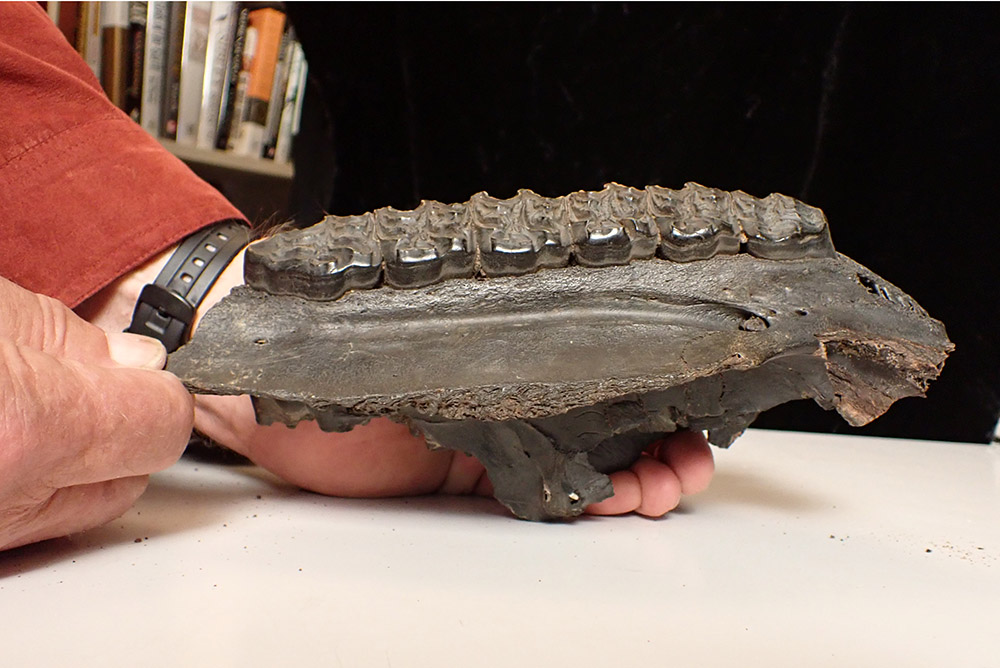
Grazers vs. Browsers
The Aucilla has preserved bones of both mammoths and mastodons, indicating a mix of nearby grasslands and forests. Looking at other fossils found at Page-Ladson, we get a sense that one ecosystem type was more prevalent here. We know this from the teeth they left behind, and from the diets of their modern relatives.
Late Pleistocene Florida was home to an extinct species of horse (Equus genus), and horses are grazers. Armadillo-like glyptodonts were also grazers.
Bison are not extinct, but they have long since departed Florida. They are grazers as well, roaming grasslands in large herds.
Large-headed llamas (Hemiauchenia macrocephala) were long thought to be grazers, but recent research indicates that they have had a diet that adapted to available habitats. In the video, you’ll hear references to camel fossils. Llamas are camelids, members of the family Camelidae, and our interviewees sometimes refer to Hemiauchenia fossils as camels.
“All of these grazers attest to the fact that there was a big grassland present in the late Pleistocene time,” says Bruce Means.
Using fossils, we can infer what plants were in an area without the remains of the plants themselves. It’s indirect, but it gives us a fuzzy outline of late Pleistocene plant life. A newer technique sharpens the image.
Analyzing Paleo-Pollen
I first reached out to Dr. Angelina Perotti in the spring, when sidewalks, my car, and the inside of my nose were coated in oak pollen. Fitting, as pollen was the reason I was calling her.
Angelina worked on Page-Ladson as a PhD student at Texas A&M, analyzing pollen in the sediment samples taken from around the fossils and artifacts at the site. The dusting we endure in the spring comes from wind-pollinated plants, which broadcast reproductive material from males in the hopes that some will land on female flowers or cones and produce seed. Much of that material lands on the ground, where it can persist for tens of thousands of years.
“Pollen is comprised of one of the strongest biomolecules in the world, called sporopollenin,” Angelina says. “What’s really useful is when we’re able to get radiocarbon dates that go along with these pollen samples, and then also other changes, like changes in the animal communities or human population at the time.”
That was what she had at Page-Ladson, pollen in a layer with animal bones and stone tools. Analyzing the pollen grains, she identifies the genus of the plants that made them. If a sediment sample has more grass and wildflower grains than tree grains, it indicates a grassland.

“What we know is that around the time that humans arrived in Florida about 15,000 years ago, it would have been a pretty open environment with herbs and grasses and things like that, with some trees here and there.” This is what the pollen at Page-Ladson showed her, a landscape with few trees.
For a forested environment, the genus of the trees tells us something as well. If a sample has more oak than pine pollen, the environment was likely wetter and shadier. A sample with more pine pollen indicates an environment similar to modern uplands in Florida, which are dominated by longleaf or slash pine over an understory of grasses. A longleaf pine savanna is a good place to start when envisioning late ice age Florida.
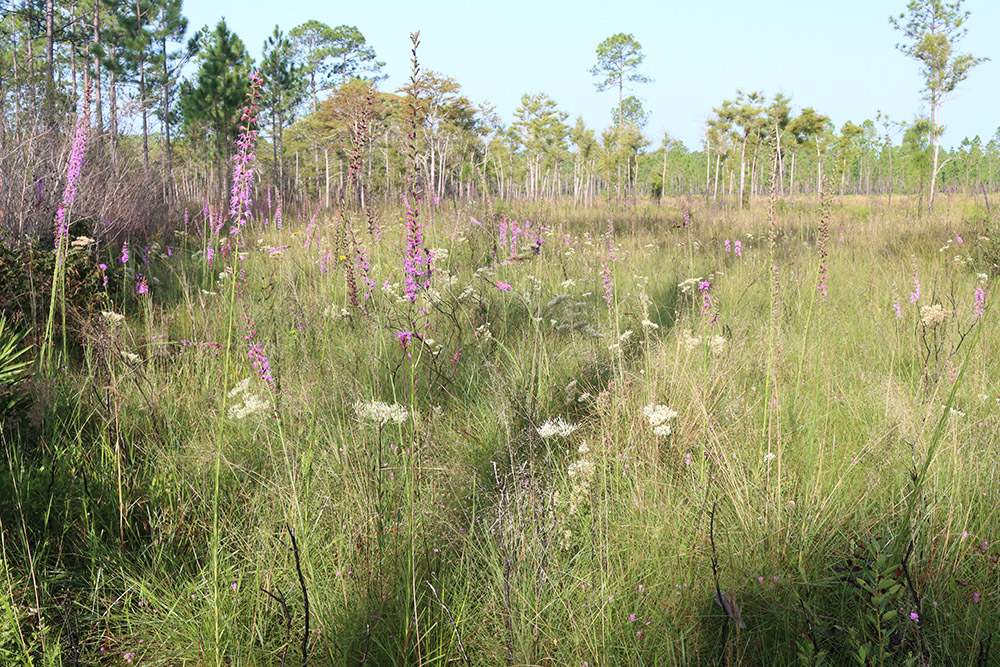
An Ice-age Version of the Longleaf Pine Ecosystem
“Longleaf pine probably was here,” says Bruce Means, “and [it] was going back and forth between these states of being fewer pines, although still a pine/ fire environment, and a woody sort of environment that supported the browsers and the grazers.”
Bruce called it a pine/ fire environment: fire is a defining feature of a longleaf pine ecosystem. If those systems burn every one to three years, it kills back hardwood species between the fireproof pines and opens the understory for grasses and wildflowers. Historically, in most varieties of longleaf habitats, the pines would have been widely spaced. The grasslands where mammoths and bison grazed were likely a version of this modern ecosystem.
Bruce mentioned that the number of pines would grow and shrink over time, which Angelina sees at one of her sites.
“At Lake Tulane, in Central Florida on the Lake Wales Ridge, it’s really interesting because you see these fluctuations between pine and oak ecosystems,” she says. The oldest sediment layer at the site is 60,000 years old, allowing her to chart ecosystem changes over tens of thousands of years. “And so, these are millennial-scale events, where basically the ecosystem, the vegetation, drastically changes. It’s kind of an oak savannah-type environment, and then the next millennium, it’s a total pine forest.”
The sediment at this and other sites also contains charcoal from wildfires. “What we find in Florida is that fire was always present on the landscape,” Angelina says.
If we remove the animals, ice-age Florida would look familiar. It had pines, open grassy areas, and fire. But how did various large plant-eaters interact with this environment?
Megafauna and Fire
One way to answer the question is to look at the differences in the landscape before and after herbivore species went extinct or left Florida.
“Prior to the decline of megaherbivores,” Angelina says, “those megaherbivores were reducing the vegetation enough that even when there were fires, maybe they weren’t big enough or widespread enough to leave a big record in ecological archives. But after their extinction, we see a pretty significant increase in fire.”
Fires need fuel to spread, and in longleaf habitats or grasslands, a primary fuel source is grass. When mammoths, horses, llamas, and bison grazed their way across the landscape, they reduced the fuel load. And their movement might have influenced plant communities in a more forceful way.
Mammoths and Mastodons: Ecosystem Engineers
“in Africa, elephants there migrate around, and when they move into the mopane woodlands,” says Bruce Means, “they eat and knock down all the mopane trees and it causes the grasses to flourish. And so for a while, a whole bunch of grazers that survive on grasses are able to feed until the elephants migrate away for a few years, and then the mopane comes back.”
Mammoths are more closely related to modern elephants than mastodons, and it’s possible that they would have had the same effect on longleaf pine. The pollen record indicates a pattern of deforesting and reforesting. Modern elephants drive a similar cycle in Africa, though on a shorter time scale.
Further research might find a different cause for the millennial ecological changes at Lake Tulane, or the increased frequency of fire after megafauna extinctions. But you can’t discount the influence of large animals on a landscape: megaherbivores are ecosystem engineers.
As Richard Hulbert says, they “affect their habitat in ways that sort of benefits them and that also benefits other animals. So the mammoths would definitely increase the grasslands in the open habitats,”
Conversely, “mastodons, by spreading seeds, would help a lot of the vegetation which is adapted for seed dispersal that way.”
Animals weren’t the only beneficiaries of mammoth and mastodon eating habits. “You think of them as predators, as on the plants. But in many ways, they are co-evolving with the plant communities to their mutual benefit.”

Stories Told by Sand
We’ve learned about ice-age Florida from its animals (through fossils) and plants (through pollen). A third method looks at the sediment itself.
In our recent post on the Ryan-Harley site, we learned that Morgan Smith found artifacts atop a layer of quartz sand. The Florida Geological Survey analyzed this layer using Optically Stimulated Luminescence, a process which, Morgan says, “dates the last time sand and quartz screens are exposed to sunlight.”
They found that the layer was likely deposited over 50,000 years ago. The layer atop it was deposited under 10,000 years ago. The sand was consistent with an Aeolian landscape, where winds blow sand onto scrubby plants, forming coppice dunes.
Ryan-Harley is on the Wacissa River, a couple miles upstream of where it joins the Aucilla. Page-Ladson is right around the bend from this confluence. Fossils and pollen have told us that the area had more grasses than trees, and now the sediment tells us that there was open sand, and dunes.
Painting a Picture with Proxy Evidence
In the show, I tried to select images of modern Florida landscapes that matched our interviewees’ descriptions of the late Pleistocene. We see coppice dunes on beaches, open grassy areas in pine savannas, and more forested pine flatwoods. Which of these best matched an ice-age Florida vista? Possibly all of them, at any given time or location. Or perhaps they’re all somewhat off.
Researchers’ descriptions were based on what archeologists call proxy evidence. They won’t find a fossil grassland, but a grassland leaves evidence of itself. We can’t know exactly how it looked then, but we can imagine that we’d see the same plant species we see now, even if they were spaced or distributed differently.
We know it was a dynamic environment. Large mammals evolved behaviors that maintained or created habitats that suited them, and perhaps their movements account for changes in habitats over time. Glaciers waxed and waned, making water more or less available throughout long cycles. Landscapes transformed themselves even before the last ice sheets melted.
By the time humans arrived in the Americas, change was constant. The final two chapters of Finding the First Floridians tell the story of people coping and adapting to that change. Cool and dry becomes warm and wet, and Florida shrinks. Humans’ largest food sources go extinct or leave Florida, but so do several life-threatening predators.
As the Pleistocene ended, and for thousands of years after, Florida cultures evolved with the landscape. One adaptation recently found by archeologists offshore shows a behavior that’s as Floridian as can be: evidence of people eating oysters.
Pleistocene Herbivores of Florida (Extinct and Extirpated)
Almost thirty animal species disappeared from Florida by the end of the last ice age, just under 12,000 years ago. The different species didn’t all go extinct at once, it was a process that unfolded over thousands of years. Some, like bison and jaguars, only went extinct within this part of their range – they were extirpated from Florida, but they persist in other parts of the Americas.
The Florida Museum of Natural History provided fossil images in Finding the First Floridians, drawing from a massive database of fossil images in their collections. They likewise provided images of projectile points. The Museum, both the exhibit hall and warehouses, is a part of the University of Florida, where museum collections are used in research projects and to educate the public about Florida ecology and history. Thank you to Dr. Richard Hulbert and the rest of the Museum staff for your immeasurable help.
Below are fossil images and short descriptions of the large extinct and extirpated herbivores present in Florida when humans first arrived here. The First Floridians would have found these alongside many of the same animals we see today, such as white-tailed deer and wild turkeys.
Columbian Mammoth (Mammuthus columbi)
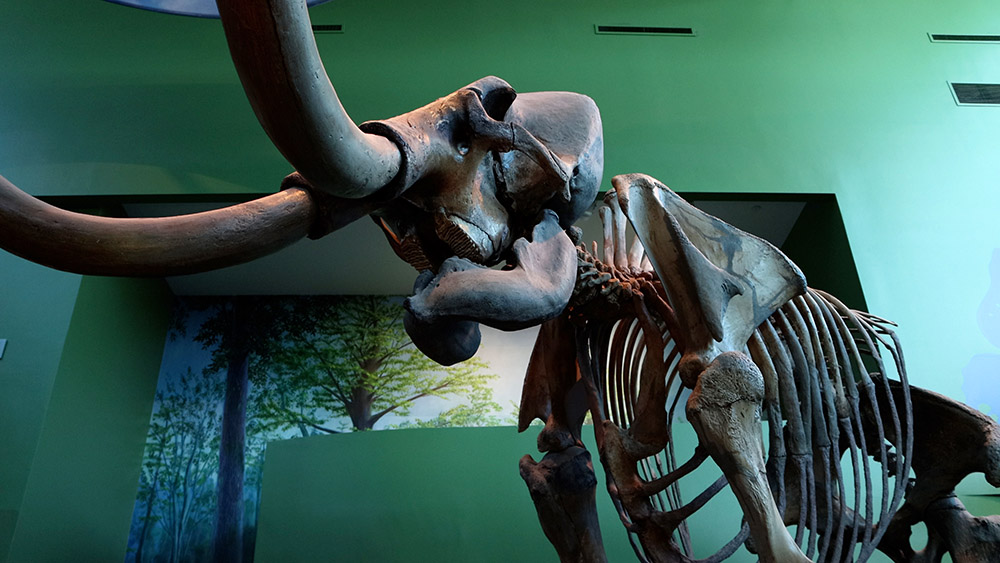
These large grazers would have roamed the landscape in large herds. A herd of elephants can be a destructive force, and they may have promoted their preferred grassland grazing habitat by pushing through stands of trees and knocking them down. As a large source of meat, their migration patterns likely influenced the movements of people as well.
American Mastodon (Mammut americanum)

Mastodons would have been drawn to areas with more trees and shrubs. They would have eaten the seeds of these plants, spreading them to promote the woody habitats that sustained them.
Large-Headed Llama (Hemiauchenia macrocephala)

Multiple teams of researchers have analyzed large-headed llama teeth to determine their diet. This animal was a browser or a grazer, adapting to available habitats.
American Bison (Bison bison)

Another grazing herd animal, bison nearly went extinct in the nineteenth century. The only wild bison remaining are in managed herds on public lands. Males can weigh a ton, while females can weigh as much as 900 pounds. Their migrations would have affected the movements of early Floridians.
Glyptodont (Boreostrocon floridanus)
A large, armadillo-like grazer.
Jefferson’s Ground Sloth (Megalonyx jeffersoni)

Richard Hulbert on Pleistocene sloths in Florida: “There were several species of ground sloth ranging in size from something about the size of a black bear up to the giant ground sloths, which… stood, fifteen, eighteen feet tall.”
This sloth would have stood around nine feet tall, and is remarkable for the person who named it – founding father Thomas Jefferson.
Richard says sloths have been found in forests and sometimes in open environments, though modern sloths are browsers. He also points out that, with their large size and claws, they would have been animals to approach with caution.
Flat-headed peccary (Platygonus compressus)

Peccaries are known as new-world pigs, the modern species of which are found in Central and South America. Flat-headed peccaries were herd animals and browsers.
Tapir (Tapirus veroensis)

A small, browsing mammal.
Finding the First Floridians was commissioned by the Archaeological Research Cooperative, and funded by a grant from the Florida Division of Historical Resources.

